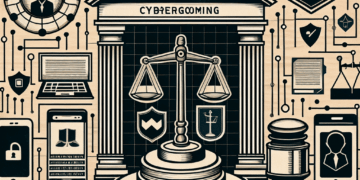Cybergrooming refers to the targeted initiation of sexual contact with minors via the internet. Perpetrators use digital means of communication to gain the trust of children and young people, manipulate them and ultimately sexually abuse or exploit them. It is a form of sexual abuse that takes place specifically in the digital space.
- Cybergrooming is the targeted initiation of sexual contact with minors via the internet.
- In Germany, cybergrooming is punishable under Section 176b StGB, including attempts since 2020.
- The phases of cybergrooming include establishing contact, building trust and sexualization.
- Offenders use false identities, gifts and technical aids for manipulation.
- Preventive measures should include education, awareness-raising and technical protective measures.
- Anonymity on the Internet makes it more difficult to prosecute offenders.
- Cybegrooming highlights the need for comprehensive child protection in the digital space.
Legal classification in Germany
In Germany, cybergrooming is explicitly punishable by law. The relevant paragraph is:
§ Section 176b StGB (Sexual abuse of children without physical contact with the child):
– It is punishable to influence a child (under 14 years of age) by means of digital media in order to induce them to engage in sexual acts.
– Since 2020, attempts are also punishable, even if the perpetrator mistakenly assumes that they are communicating with a child.
Penalty:
– imprisonment from three months to five years
Phases of cybergrooming
1. making contact: Offenders specifically search for potential victims in social networks, chats or online games.
2. building trust: An emotional bond is established through attention and understanding.
3. information gathering: The perpetrator collects personal information about the victim.
4. isolation: the child is encouraged to keep the online relationship secret.
5. sexualization: gradual introduction of sexual topics into communication.
6. blackmail or persuasion: Pressure to perform sexual acts or to meet in person.
Offender methods and strategies
1. false identities: Pretending to be a minor
2. Gifts and attention: Material and emotional attention
3. Exploitation of insecurities: Targeting vulnerable children
4. Technical aids: Use of webcams, image editing software, etc.
5. blackmail: threat to publish compromising content
Preventive measures
1. sex education: age-appropriate sex education and media literacy promotion
2. awareness-raising: training for parents, teachers and caregivers
3. technical protective measures: Parental control settings, filter programs
4. culture of trust: promoting open communication between children and trusted persons
5. strengthening self-confidence: strengthening children in their self-awareness and self-assertion
Challenges for law enforcement
1. anonymity on the Internet: Difficulty in identifying perpetrators
2. international dimension: cross-border cases make prosecution more difficult
3. technical complexity: constantly new platforms and communication channels
4. number of unreported cases: many cases are not reported out of shame or ignorance
5. preservation of evidence: the volatility of digital traces
Significance for the digital society
Cybergrooming highlights the need for comprehensive child protection in the digital space. It shows the dark side of increasing networking and underlines the importance of media literacy and a critical approach to online communication.
Current developments and trends
1. increase in cybergrooming during the COVID-19 pandemic
2. Shift to encrypted messaging services and the darknet
3. Use of AI to detect grooming patterns
4. Increased international cooperation in law enforcement
5. Development of specialized prevention programs for schools and youth facilities
Conclusion
Cybergrooming poses a serious threat to the well-being of children and young people in the digital world. The legal framework in Germany provides a good basis for prosecution, but preventing and combating it requires a holistic approach. This must combine technical, educational and social measures. Continuous adaptation of strategies to new technological developments and forms of communication is essential. At the same time, strengthening the media skills and self-confidence of children and young people remains a central task in order to protect them from the dangers of cybergrooming.





















